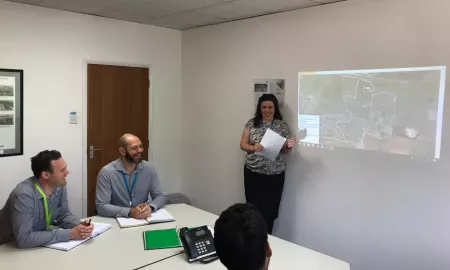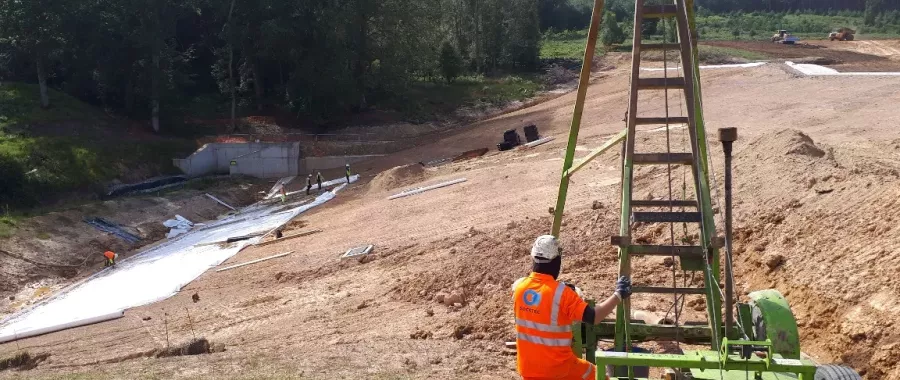Peter Hepton, engineering manager (ground investigation), SOCOTEC, outlines the case for standards and sample quality for ground investigations to avoid risks that potentially go beyond negative financial implications on projects.

The John Mitchell Lecture, organised by the Institution of Civil Engineers (ICE) back in January 2018, discussed rethinking site investigation, design practice and procurement. It was observed that, while most engineering materials perform to a specification, the ground is 'inherited', and any construction project may be at risk if adverse or unexpected ground conditions are not recognised at an early stage.
Last minute design changes, delays and additional costs can be avoided by conducting a thorough ground investigation. Failure to invest in adequate ground investigation due to an inability to see the value in the process may prove to be a false economy, as the potential consequences of a poorly executed ground investigation may be costly beyond simple negative financial implications. These risks and their consequences have been supported for decades and reported on many times but not much seems to have changed.
Planning a ground investigation
Ground investigation is not simply turning up at a site and 'doing some boreholes'. The exploratory work must be designed to ensure a suitably focused ground investigation is carried out; that means proposing works that are relevant to the project, while also taking into account the anticipated ground conditions and the likely geohazards.
For many years, investigations in the UK were carried out with reference to the British Standard Code of Practice for Site Investigations (BS 5930) which covered activities from planning to fieldwork, in-situ testing and reporting. Following alignment with European standards in 2010, in the UK now falls within a set of British Standards, in particular BS EN 1997-2:2007 Eurocode 7 - Geotechnical design - Part 2: Ground investigation and testing.
Related to this is a series of other standards, including those for sampling, field and laboratory testing, and soil and rock description - to name a few - plus others for geotechnical design. Despite still being regarded as 'recent' standards by the industry, updates to EC-7 (the design codes) are soon to be released as a “draft for comment”. Other standards have similarly been updated within this relatively short period. Interestingly, current revision of BS EN 1990 and 1991(so called Eurocode 0 - Basis of structural design and Eurocode 1 - Actions on structures) are to include geotechnical aspects which are now being recognised as fundamental to the structural considerations. However, BS 5930 is still in use – the last publication in 2015 has continued the ongoing alignment with European standards. This first started in 2007 with Amendment 1 to the 1999 edition.
With the number of different standards now in place, it has become more difficult for specifiers to be fully aware of the existence and status of these, and it is not uncommon to see ground investigation specifications with reference to superseded standards.
Sample quality
The key to successful ground investigation is the need to recover representative specimens of the ground, both for inspection – to assess the geological context and the behavioural type of the material – and for geotechnical laboratory testing.
The control of sample quality, both soil and rock, is outlined in BS EN ISO 22475-1:2006 Geotechnical investigation and testing – sampling methods and groundwater measurement. This names the Quality Classes of different sampling methods in relation to properties that can be determined, including description. For example, laboratory measurement of compressibility and shear strength – commonly required parameters used for foundation design – require Achievable Quality Class 1 samples, usually referred to as simply 'Class 1 samples'.
The scoping of a ground investigation should therefore consider the parameters that will be required for the geotechnical design, and the corresponding quality class of samples necessary for testing. Selection of the appropriate sampling methods will then dictate the type of exploratory holes required.
However, it should be appreciated that employing a Class 1 sampling method is not guaranteed to deliver a Class 1 sample. Open drive tube samples of Class 1, and even Class 2, are commonly referred to as undisturbed samples, but in reality all samples are disturbed to some extent. This disturbance can occur for a number of reasons, such as stress changes in the borehole (even before sampling has occurred), during extraction of samples from the ground, transportation, storage, laboratory extrusion and even test preparation. Without good sample-handing processes in place, physical shock, vibration effects and temperature changes may also occur and affect the sample. Some laboratory tests attempt to recreate in-situ stress conditions, for example, through reconsolidation or via stress/strain paths, but these techniques cannot recover larger scale disruptions to sample structure.
There are also practical limitations to the operation of the sampling equipment; ground conditions may impede the use of a UT100 (thin wall tube) sampler in soil containing a high coarse particle content, for example. Another example could be that, in higher strength over-consolidated clay, rotary coring may provide a higher quality sample compared to a driven tube. Whether an undisturbed sample containing coarse gravel size particles will be suitable for, say, triaxial testing is of course another matter for discussion.
Those specifying ground investigations may not be fully acquainted with the implications of different drilling and sampling methods on sample quality. Early engagement with a competent contractor will be beneficial to discuss the project requirements and the options available for drilling, sampling and laboratory testing. However, it is also important to note that leaving the scope of works to the contractor at the investigation tendering stage is unlikely to be satisfactory if comparison of tenders is based solely on cost. The tender that provides the cheapest investigation price, simply by doing less work, has probably failed to suitably recognise and consider the level of risk control required.
Quality control
To perform routine laboratory tests, samples must meet certain requirements in terms of the minimum amount of suitable material below specified particle sizes, organic content, etc. However, there is currently no routine laboratory test for assessment of 'undisturbed' sample quality, other than by visual inspection for gross disturbance. A number of methods have been used, particularly for specialist 'advanced' testing, but these are dependent and specific to each individual project. Regardless, once testing is underway in the laboratory, identifying deficiencies is likely to come too late in the investigation process to allow any changes to be made at site level to improve or rectify problems.
Ensuring sample quality control during fieldworks requires competent field crews who have experience of the relevant sampling methods and the ground conditions; appropriate well-maintained equipment is also an important factor. Suitable measures for subsequent sample handling and storage are also required.
The technical site staff, engineers and geologists undertaking supervision and sample logging should be knowledgeable in the particular project requirements, the drilling and sampling methods being used, and the ground conditions for the site. Early identification of any deficiencies in the quality of samples recovered requires a team approach to highlight any concerns and discuss alternative options, where necessary.
A good ground investigation contractor will employ staff with a range of expertise to meet the challenges of different geographical ground conditions; drilling supervisors to advise on drilling and sampling in problematic materials, such as low strength, unconsolidated and mixed materials like Sherwood Sandstone, Chester Formation and Chalk containing flints.
Formation specialist logging geologists will be knowledgeable in the particular requirements for describing, classifying and handling materials such as Chalk, Mercia Mudstone and London Clay Formations. Training may be provided internally by company experts, and externally from recognised industry or academic experts. High profile project clients are now often appointing their own Formation Specialists to liaise with the ground investigation team, providing guidance and checking as required, to ensure that all are working towards the required end product in terms of borehole logs, test results and other reports.
Technology
Making use of the advances in ground investigation data capture, collation and sharing can provide efficiencies and enhance the reliability of data. Bespoke mobile devices used by drillers to record borehole information ensure that all the required data is collected through use of mandatory data input fields, such as SPT hammer ID, while also incorporating logic checks to avoid depth and date mismatches, for example. Data recovered by logging and monitoring site staff can be similarly captured.
By using the industry wide AGS4 data format within the data management systems, interchange of information during the project can rapidly take place. Preliminary borehole information, test schedules and laboratory test data can be quickly exchanged between parties, and ensures consistency of the reference information.
Other technologies, such as use of drilling parameter monitoring, are also beginning to emerge and are expected to become more prevalent in the future.
When looking for a partner to complete ground investigation works, it is usually advantageous to choose a suitably experienced and knowledgeable contractor who can put forward a team of professionals familiar with the ground conditions and requirements of similar project objectives, and who understand the relevant drilling methods, as well as the technological reporting formats used to convey the data back to the specifiers and design team.
The British Drilling Association has developed a Buyer’s Guide to its member firms to facilitate the selection of appropriate specialists for ground investigations. This will be available in 2019.
* This article was written for and first published in Geodrilling International.
Want to find out more about how SOCOTEC can support your ground investigation requirements?
Our team of experts can provide a complete integrated package of site investigation services covering the whole project lifecycle.

You might also like







Add new comment